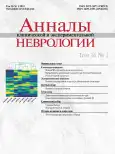Corticobasal syndrome as a phenotype of various neurodegenerative disorders: a case series
- 作者: Shpilyukova Y.A.1, Fedotova E.Y.1, Illarioshkin S.N.1
-
隶属关系:
- Research Center of Neurology
- 期: 卷 16, 编号 1 (2022)
- 页面: 64-70
- 栏目: Clinical analysis
- URL: https://journals.rcsi.science/2075-5473/article/view/124085
- DOI: https://doi.org/10.54101/ACEN.2022.1.9
- ID: 124085
如何引用文章
全文:
详细
Corticobasal syndrome (CBS) is a variant of atypical parkinsonism. The underlying cause may be corticobasal degeneration or other proteinopathies, which can be verified only after studying specific biomarkers. The disease aetiology in CBS needs to be established to determine the disease prognosis. It can also affect the choice of pathogenetic treatment due to the differences in the molecular pathogenesis of proteinopathies that cause neurodegenerative processes. Four clinical cases of CBS are presented: in patients with four-repeat tauopathy, Alzheimer's disease, frontotemporal dementia and Creutzfeldt–Jakob disease. Examples are provided of the clinical, genetic and biochemical biomarkers available for differential diagnosis of CBS.
作者简介
Yuliya Shpilyukova
Research Center of Neurology
编辑信件的主要联系方式.
Email: annaly-nevrologii@neurology.ru
ORCID iD: 0000-0001-7214-583X
Cand. Sci. (Med.), junior researcher, neurologist, 5th Neurology department
俄罗斯联邦, MoscowEkaterina Fedotova
Research Center of Neurology
Email: annaly-nevrologii@neurology.ru
ORCID iD: 0000-0001-8070-7644
D. Sci. (Med.), Head of the 5th Neurology department
俄罗斯联邦, MoscowSergey Illarioshkin
Research Center of Neurology
Email: annaly-nevrologii@neurology.ru
ORCID iD: 0000-0002-2704-6282
D. Sci. (Med.), Prof., Corr. Member of the Russian Academy of Sciences, Deputy Director, Head, Department for brain research
俄罗斯联邦, Moscow参考
- Armstrong M.J., Litvan I., Lang A.E. et al. Criteria for the diagnosis of corticobasal degeneration. Neurology. 2013;80(5):496–503. doi: 10.1212/WNL.0b013e31827f0fd1. PMID: 23359374.
- Gibb W.R.G., Luthert P.J., Marsden C.D. Corticobasal degeneration. Brain. 1989;112(5):1171–1192. doi: 10.1093/brain/112.5.1171. PMID: 2478251.
- Dickson D.W., Bergeron C., Chin S.S. et al. Office of rare diseases neuropathologic criteria for corticobasal degeneration. J Neuropathol Exp Neurol. 2002;61(11):935–946. doi: 10.1093/jnen/61.11.935. PMID: 12430710.
- Ling H., O’Sullivan S.S., Holton J.L. et al. Does corticobasal degeneration exist? A clinicopathological re-evaluation. Brain. 2010;133(7):2045–2057. doi: 10.1093/brain/awq123. PMID: 20584946.
- Hassan A., Whitwell J.L., Josephs K.A. The corticobasal syndrome-Alzheimer’s disease conundrum. Exp Rev Neurother. 2011;11(11): 1569–78. doi: 10.1586/ern.11.153. PMID: 22014136.
- Boyd C., Tierney M., Wassermann E. et al. Sensitivity and specificity of new criteria for the diagnosis of corticobasal degeneration. Neurology. 2015;84(14 Supplement):P5.010. URL: https://n.neurology.org/content/84/14_supplement/ p5.010
- Höglinger G.U., Respondek G., Stamelou M. et al. Clinical diagnosis of progressive supranuclear palsy: The movement disorder society criteria. Mov Disord. 2017;32(6):853–864. doi: 10.1002/mds.26987. PMID: 28467028.
- Ling H., Macerollo A. Is it useful to classify PSP and CBD as different disorders? Yes. Mov Disord Clin Pract. 2018;5(2):145–148. doi: 10.1002/mdc3.12581. PMID: 30363457.
- Höglinger G.U. Is it useful to classify progressive supranuclear palsy and corticobasal degeneration as different Disorders? No. Mov Disord Clin Pract. 2018;5(2):141–144. doi: 10.1002/mdc3.12582. PMID: 30363409.
- Respondek G., Grimm M.J., Piot I. et al. Validation of the movement disorder society criteria for the diagnosis of 4-repeat tauopathies. Mov Disord. 2020;35(1):171–176. doi: 10.1002/mds.27872. PMID: 31571273.
- Fedotova E.Yu., Chechetkin А.О., Ivanova-Smolenskaia I.A., Illarioshrin S.N. [A case of progressive supranuclear palsy with corticobasal syndrome]. Nervnyye bolezni. 2009;(2):38–43. (In Russ.)
- Vasenina E.E., Levin O.S. [Contemporary approaches to clinical diagnosis and treatment of tau-protein accumulation related multisystem degenerations]. Zh Nevrol Psikhiatr Im S S Korsakova. 2020;120(2):22–30. doi: 10.17116/jnevro202012010222. PMID: 33205927 (In Russ.)
- Doronina O.B., Aftanas L.I., Doronina K.S. [Heterogenity of clinical signs and symptoms, and biomarkers of atypical parkinsonism]. Nervnyye bolezni. 2017;2:35–39. (In Russ.)
- Belyakova-Bodina A.I., Bril’ E.V., Zimnyakova O.S. et al. [Videonystagmography in the diagnosis of oculomotor disorders]. Annals of clinical and experimental neurology. 2017;11(4):52–64. doi: 10.18454/ACEN.2017.4.6. (In Russ.)
- Zerr I., Kallenberg K., Summers D.M. et al. Updated clinical diagnostic criteria for sporadic Creutzfeldt–Jakob disease. Brain. 2009;132(10):2659–2668. doi: 10.1093/brain/awp191. PMID: 19773352.
补充文件







